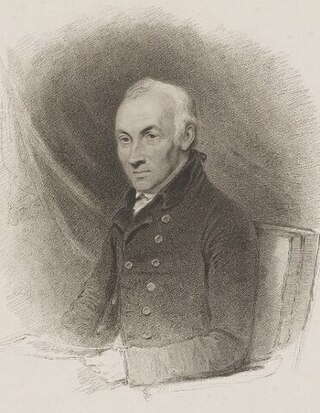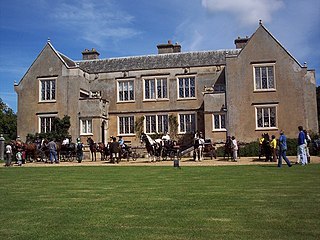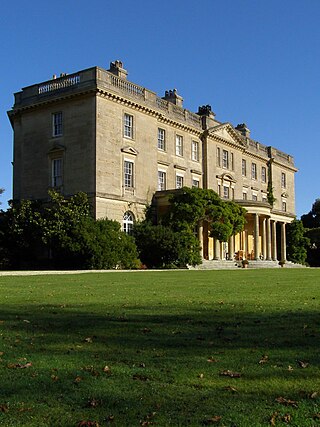
William Mitford was an English historian, landowner, and politician. His best known work is The History of Greece, published in ten volumes between 1784 and 1810.

In the 19th century members of the English Rothschild family bought and built many country houses in the home counties, furnishing them with the art the family collected. The area of the Vale of Aylesbury, where many of the houses were situated, became known as "Rothchildshire". In the 20th century many of these properties were sold off with their art collections dispersed. Today only Eythrope House still belongs to the family; however, they still retain influence in how Ascott House and Waddesdon Manor are managed. In the loss of country houses in the 20th century only Aston Clinton was lost.

Marchwood is a village and civil parish located in Hampshire, England. It lies between Totton and Hythe on the western shore of Southampton Water and directly east of the New Forest. The population of the village in the 2011 census was 6,141.

Lyndhurst is a large village and civil parish situated in the New Forest National Park in Hampshire, England, about nine miles (14 km) south-west of Southampton. Known as the "Capital of the New Forest", Lyndhurst houses the New Forest District Council and Court of Verderers. It is also a popular tourist attraction, with many independent shops, art galleries, cafés, museums, pubs and hotels. As of 2001 Lyndhurst had a population of 2,973, increasing to 3,029 at the 2011 Census.

Fawley is a village and civil parish in Hampshire, England. It is situated in the New Forest on the western shore of the Solent, approximately 7 miles south of Southampton. Fawley is also the site of Fawley Refinery, operated by ExxonMobil, which is the largest facility of its kind in the United Kingdom. The decommissioned Fawley Power Station is also located less than a mile to the south east of the village.

Holbury is a village in Hampshire, England. It is part of the parish of Fawley.

Exbury Gardens is a 200-acre (81 ha) informal woodland garden in Hampshire, England with large collections of rhododendrons, azaleas and camellias, and is often considered the finest garden of its type in the United Kingdom. Exbury holds the national collection of Nyssa (Tupelo) and Oxydendrum under the National Plant Collection scheme run by the Plant Heritage charity. The gardens are rated Grade II* on the National Register of Historic Parks and Gardens.

Major Lionel Nathan de Rothschild, OBE was a British banker and Conservative politician best remembered as the creator of Exbury Gardens by the New Forest in Hampshire. He was the eldest son of Leopold de Rothschild (1845–1917) and a part of the prominent Rothschild banking family of England. In 1910, he was elected to the House of Commons. In 1917, he co-founded the anti-Zionist League of British Jews.

Dibden is a small village in Hampshire, England, which dates from the Middle Ages. It is dominated by the nearby settlements of Hythe and Dibden Purlieu. It is in the civil parish of Hythe and Dibden. It lies on the eastern edge of the New Forest in a valley, which runs into Southampton Water.

Minstead is a small village and civil parish in the New Forest, Hampshire, about 2 miles (3.2 km) north of Lyndhurst. There is a shop and a pub, the Trusty Servant. Sir Arthur Conan Doyle's grave is under a large tree at the back of the 13th-century All Saints' church.

Sway is a village and civil parish in Hampshire in the New Forest national park in England. The civil parish was formed in 1879, when lands were taken from the extensive parish of Boldre. The village has shops and pubs, and a railway station on the South West Main Line from Weymouth and Bournemouth to Southampton and London Waterloo. It is the site of Sway Tower, a 66-metre (217 ft) concrete folly built in the 19th century. The outbuildings of the Grade II listed Forest Heath House are used as artist studios and exhibition space by the charity SPUDWorks.
Charlotte Henriette de Rothschild is a British soprano, specialising in the recital and oratorio repertoire, who is a member of the Rothschild banking family of England.
Major Edmund Leopold de Rothschild was an English financier, a member of the prominent Rothschild banking family of England, and a recipient of the Victoria Medal of Honour (VMH), given by the Royal Horticultural Society.

Langley is a small village in the civil parish of Fawley in Hampshire, England.

Lepe is a linear hamlet on the Solent in south-west Hampshire, England. In the civil parish of Exbury and Lepe, It is beside the Dark Water, and has Lepe Country Park, which runs from Stanswood Bay to the mouth of the Beaulieu River.

Netley Marsh is a village and civil parish in Hampshire, close to the town of Totton. It lies within the New Forest District, and the New Forest National Park. It is the supposed site of the battle between an invading Anglo Saxon army, under Cerdic and a British army under the probably fictitious king Natanleod in the year 508.

Denny Lodge is a large civil parish in the New Forest in Hampshire, England. It covers a large area of heathland and woodland encompassing much of the eastern side of the New Forest, but contains no towns, villages, churches, or schools.

Bisterne is a hamlet in the civil parish of Ringwood in the New Forest National Park in Hampshire, England. Its nearest town is Ringwood, which lies 3 miles (4.8 km) to the north.

Exbury House is an English country house in Exbury and Lepe, Hampshire, situated on the edge of the New Forest.

Ashley is a village located in the southwest of Hampshire, England. It lies on the eastern outskirts of New Milton in the New Forest district, and is two miles (3 km) inland from the sea. Its history dates back to the Domesday book of 1086, when two estates were recorded. In the 15th century much of Ashley merged with a neighbouring manor, and the estate became known as Ashley Arnewood. As a village, Ashley began to develop in the 19th century when a church and a school were built. Most of the current village was built in the 20th century, and today Ashley is effectively a suburb of New Milton.






















